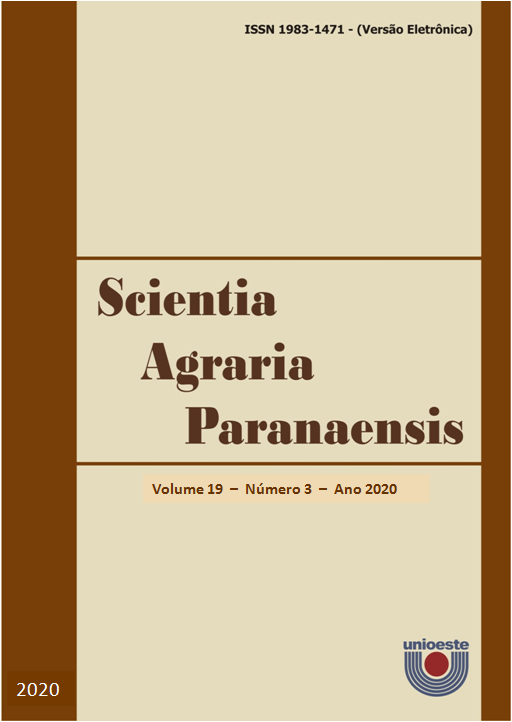Phytosociology of weeds in coffee plants with different soil management techniques
DOI:
https://doi.org/10.18188/sap.v19i3.24200
Agências de fomento
CNPq, CAPES, FAPEMIG, INOVACAFÉ e Consorcio Pesquisa Café
Resumo
The adoption of different soil management techniques in coffee plants can alter the phytosociology of the weed community and, therefore, identifying the technique that most contributes to an integrated weed management is fundamental. In this context, the objective of this study was to evaluate the phytosociology of weeds in coffee plants under different soil management techniques. The land was planted in January 2016 with coffee seedlings of the species Coffea arabica L., cultivar Mundo Novo IAC 379-19. The design used was in randomized blocks, arranged in a 2 x 6 factorial scheme, with 3 replications. Two evaluations were carried out: in the rainy season and in the dry season, in 2017. The management techniques applied inter-rows were: i) control (spontaneous vegetation in the area); ii) management with Urochloa decumbens. On the coffee in-rows, the treatments were: iii) coffee husk; iv) organic compound; v) plant residues of U. decumbens; vi) plant residues of U. decumbens with coffee husk; vii) plant residues of U. decumbens with organic compound; viii) control (without coverage). For the evaluations, a square (0.25 m²) was randomly launched and the phytosociological indices were subsequently calculated. The species of the families Poaceae and Asteraceae were the most frequent in the area. The management with U. decumbens inter-rows and the crop residues deposited in the row associated with the coffee husk, or organic compound, decreases the amount and the diversity of weed species.Downloads
Publicado
03-11-2020
Como Citar
ALECRIM, A. O.; CASTANHEIRA, D. T.; VOLTOLINI, G. B.; NETTO, P. M.; GUIMARÃES, R. J.; GONÇALVES, A. H. Phytosociology of weeds in coffee plants with different soil management techniques. Scientia Agraria Paranaensis, [S. l.], v. 19, n. 3, p. 270–279, 2020. DOI: 10.18188/sap.v19i3.24200. Disponível em: https://e-revista.unioeste.br/index.php/scientiaagraria/article/view/24200. Acesso em: 16 dez. 2025.
Edição
Seção
Artigos Científicos
Licença
Aviso de Direito Autoral Creative Commons
Política para Periódicos de Acesso Livre
Autores que publicam nesta revista concordam com os seguintes termos:
1. Autores mantém os direitos autorais e concedem à revista o direito de primeira publicação, com o trabalho simultaneamente licenciado sob a Licença Creative Commons Attribution que permite o compartilhamento do trabalho com reconhecimento da autoria e publicação inicial nesta revista.2. Autores têm autorização para assumir contratos adicionais separadamente, para distribuição não-exclusiva da versão do trabalho publicada nesta revista (ex.: publicar em repositório institucional ou como capítulo de livro), com reconhecimento de autoria e publicação inicial nesta revista.
3. Autores têm permissão e são estimulados a publicar e distribuir seu trabalho online (ex.: em repositórios institucionais ou na sua página pessoal) a qualquer ponto antes ou durante o processo editorial, já que isso pode gerar alterações produtivas, bem como aumentar o impacto e a citação do trabalho publicado (Veja O Efeito do Acesso Livre).
Licença Creative Commons
Esta obra está licenciada com uma Licença Creative Commons Atribuição-NãoComercial-CompartilhaIgual 4.0 Internacional, o que permite compartilhar, copiar, distribuir, exibir, reproduzir, a totalidade ou partes desde que não tenha objetivo comercial e sejam citados os autores e a fonte.


